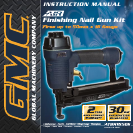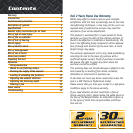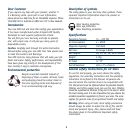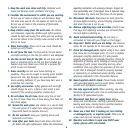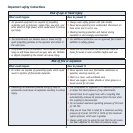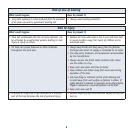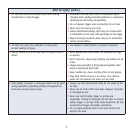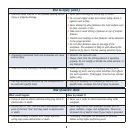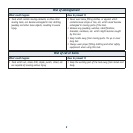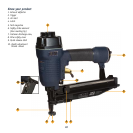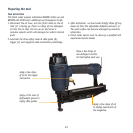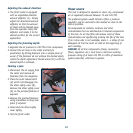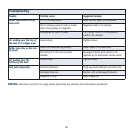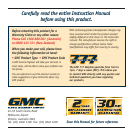
8
Risk to injury (cont.)
• Fasteners could ricochet or be propelled causing serious
injury or property damage.
• Never point discharge of tool at self or others.
• Do not pull trigger unless tool contact safety device is
against work surface.
• Never attempt to drive fasteners into hard surfaces such
as steel, concrete, or tile.
• Take care to avoid driving a fastener on top of another
fastener.
• Position tool carefully so that fasteners will be delivered
to the proper location.
• Do not drive fasteners close to the edge of the
workpiece. The workpiece is likely to split allowing the
fastener to fly free or ricochet causing personal injury.
• Improperly maintained tools and accessories can cause
serious injury.
• Maintain the tool with care.
• Always check that the striking element is operating
properly. Do not modify or disable the strike element, or
any tool parts.
• There is a risk of bursting if the tool is damaged. • Check for misalignment or binding of moving parts,
breakage of parts, and any other condition that affects
the tool’s operation. If damaged, have the tool serviced
before using.
• Use only accessories identified by the manufacturer to
be used with specific tools.
• Use of an accessory not intended for use with the
specific tools, increases the risk of injury to persons.
Risk of electric shock
What could happen How to prevent it
• Using air tools to attach electrical wiring may result in
electrocution or death.
• Never use a nailer to attach electrical wiring while
energized.
• Contact with a “live” wire will also make exposed metal
parts of the tool “live” and may result in electrocution
or death.
• Avoid body contact with grounded surfaces such as
pipes, radiators, ranges, and refrigerators. There is an
increased risk of electric shock if your body is grounded.
• Fasteners coming in contact with hidden electrical
wiring may cause electrocution or death.
• Thoroughly investigate the workpiece for possible
hidden wiring before performing work.



